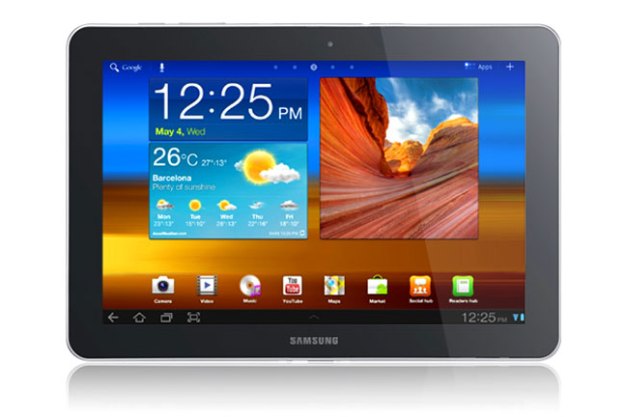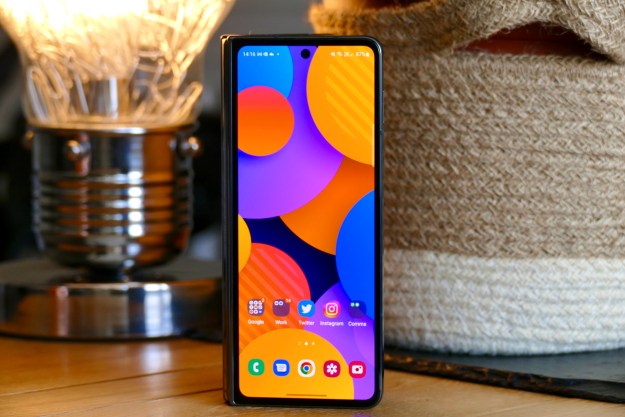
“The Galaxy Tab 10.1 fixes most of the form factor issues we've had with previous Android tablets, making it the best alternative to Apple's iPad.”
- Thin and lightweight
- Wide viewing angle
- Outward-facing stereo speakers
- Competitive spec sheet
- Android 3.1 included
- 10 full hours of battery
- No micro USB or microSD
- Dongles required for extra devices
- Camera app needs work
- Plastic shell with slippery back plate
The iPad 2 is currently the gold standard for tablets. It’s thin, responsive, and arguably the best looking tablet on the market. Samsung isn’t happy about this, or the fact that the iPad commands an overwhelming majority of the tablet market in the U.S. and abroad. Samsung first introduced its Galaxy Tab 10.1 in February, but after Apple debuted the razor-thin iPad 2, a redesigned and much thinner Galaxy Tab debuted in March at CTIA. The goal was to match or exceed the iPad 2 in all physical ways. The 10.1 was even tweaked again in April to achieve this ambitious goal. They say to beat the man, you gotta be the man. For the day, Samsung is certainly the man. The Galaxy Tab 10.1 is the closest an Android tablet has gotten to matching the iPad in design, weight, and thinness. In some categories, it actually exceeds Apple’s standards.
Design
Samsung isn’t ready to change anything about the tablet form factor, but the 10.1 does perfect it. The final design measures 0.34 inches thick — exactly the thickness of the iPad 2, and a huge improvement over thicker units like the Acer Iconia Tab A500 and Motorola Xoom. Better still, it is actually a bit lighter than the iPad and about half a pound lighter than any other tablet, allowing you to more easily hold the 10.1-inch touchscreen with one hand.

Samsung achieves this thin, lightweight design by cutting a few corners. The 1280 x 800 pixel screen has a wide viewing angle and is still made from Gorilla Glass, with a little less than an inch of black bezel surrounding it, but Samsung has opted to produce much of the unit out of plastic. Replacing the aluminum frame of the iPad is a lighter plastic shell that’s been painted silver to hide its origins. Likewise, the back of the unit, which used to be black, is now covered in a slick white plastic, which tends to get a bit slippery and take on smudges rather easily. Smudges aside, every Galaxy Tab 10.1 comes in all three tech colors: black, silver, and white. Indecisive potential iPad buyers who can’t decide on black or white need not look any further. Samsung is offering all in one.
All-in-one is the motto for ports as well. While most tablets come with a MicroSD slot, micro HDMI, microUSB, and sometimes (thank you Iconia Tab) a full USB port, the Galaxy Tab 10.1 offers none of these. Instead, Samsung has opted for an iPad-like universal port on the bottom (landscape) of the unit. Using this port and separately sold adapters, you can connect most anything you desire. Samsung includes a USB adapter. While we aren’t currently hooking a lot up to our tablets, Android 3.1 does allow your tablet to operate as a USB host for devices like cameras, printers, and keyboards. So if you have lofty connectivity goals, be prepared to shell out a bit extra for the necessary dongles.

A power button and volume rocker adorn the top of the unit, which defaults to landscape. Both are well placed and easy to press, which is a good thing, as you’ll be using the volume a bit more often because of the unit’s twin outward facing speakers, plenty powerful for a tiny tablet and definitely better than the rear-facing speakers on most tablets. After all, who wants their speakers muffled by whatever surface the tablet’s sitting on? A stereo jack is also located up top, if you prefer
Android 3.1 (Honeycomb)
The Galaxy Tab 10.1 is almost a pure Google experience, but Samsung has made a few minor alterations, most of them with good intent. For one, they’ve been listening to

In addition to keeping things simple, Samsung’s tablet comes with
Overall, we found the Galaxy Tab 10.1 desktop to be ever so slightly slower than the Motorola Xoom, which may be the best performing tablet when upgraded to 3.1. This is odd, since both the Xoom and Galaxy Tab 10.1 run very similar specs. The 10.1 runs on a dual-core 1GHz Nvidia Tegra 2 processor, has 1GB of
Apps and web
There is very little bloatware on the Galaxy Tab 10.1. Samsung has packed in a few apps, like Pulse Reader, Music Hub, QuickOffice, and a Samsung Apps store, but they’re non-intrusive and useful for those interested. The Samsung Apps store is a bit odd, though. Unlike HTC’s app store, this does not connect up with the
Camera
The Galaxy Tab comes with a 3.0-megapixel rear camera with autofocus, flash and a 2-megapixel front camera (without autofocus or a flash). Though the rear camera is weaker than many of its competitors, including the Xoom, it manages to pick up a lot more color than Motorola’s tablet. Overall, it seems to work well, but Samsung’s custom Camera App is slow at autofocusing and lacks a zoom function at all. It also doesn’t show the Honeycomb menu buttons, which tells us that it may have been ported from Samsung’s

However, the loss of zoom doesn’t hurt as much after you try out Google’s new Movie Studio app, which offers basic cutting and splicing capabilities, allowing you to easily edit together short movies from your tablet. Though its likely missing a ton of features professional movie editors would demand, its easy to lay down some scenes, transitions, and an audio track. For 90 percent of people, this is more than enough. Movie Studio comes preloaded.
Battery life
Battery life is a problem on all tablets and phones, but the Galaxy Tab 10.1 keeps up with the best of them, offering about 10 hours of intense use before needing a recharge, comparable to the iPad or any other tablet. We haven’t compared it to another tablet side-by-side for 10 hours straight, but found that
Conclusion
Samsung’s redesigned Galaxy Tab 10.1 might be the best
Samsung knows its enemy and has targeted the competition quite clearly. The Galaxy Tab 10.1 fixes most of the form factor issues we’ve had with previous
Highs:
- Thin and lightweight
- Wide viewing angle
- Outward-facing stereo speakers
- Competitive spec sheet
- Android 3.1 included
- 10 full hours of battery
Lows:
- No micro USB or microSD
- Dongles required for extra devices
- Camera app needs work
- Plastic shell with slippery back plate
Editors' Recommendations
- The best Samsung Galaxy Z Fold 4 deals
- Best Samsung Galaxy S22 deals: Save big on unlocked models
- Samsung Galaxy Ring: news, rumored price, release date, and more
- The 20 best Samsung Galaxy Watch faces you should be using
- A surprise phone just beat the Galaxy S24 Ultra in a big way



